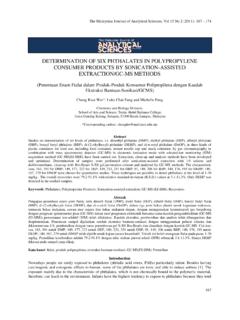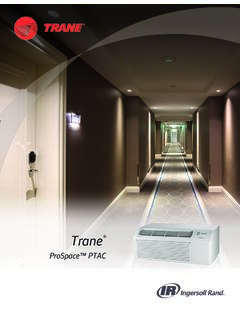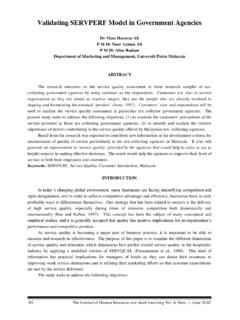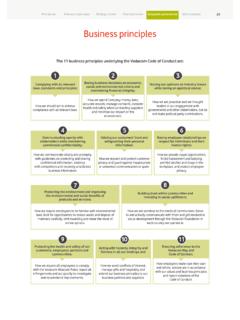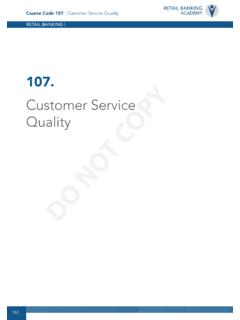Transcription of IMPLEMENTATION OF SIX SIGMA IN SERVICE INDUSTRY
1 Journal of Quality Measurement and Analysis Jurnal Pengukuran Kualiti dan AnalisisIMPLEMENTATION OF SIX SIGMA IN SERVICE INDUSTRY (Pelaksanaan Enam SIGMA dalam Industri Perkhidmatan)AMINUDIN OMAR & ZAINOL MUSTAFAABSTRACTAs providing high quality services becomes the major focus in many SERVICE organisations, a better understanding of the unique characteristics of services offered will be of advantage. This in turn will help assist in identification of areas to improve by IMPLEMENTATION of quality program initiatives such as Six SIGMA in such organisation. Many SERVICE processes are not visible, intangible, and even immeasurable.
2 As such, they are not amendable to improvement using a Six SIGMA approach. This thinking has turned out to be rather presumptuous at least for the health care, banking, and call centre services which have successfully implemented Six SIGMA in their daily operations. Other services such as education and hospitality are also beginning to apply Six SIGMA quality initiatives. This paper provides summary of limitations and suggestions for IMPLEMENTATION of Six SIGMA in the SERVICE industriesKeywords: Six SIGMA ; SERVICE INDUSTRY ; qualityABSTRAKM emandangkan kualiti perkhidmatan yang baik telah menjadi fokus utama organisasi yang menawarkan perkhidmatan, maka pemahaman mendalam terhadap ciri-ciri perkhidmatan yang ditawarkan itu amatlah membantu.
3 Ini secara tidak langsung akan membantu mengembangkan inisiatif kualiti perkhidmatan seperti amalan Enam SIGMA dalam industri perkhidmatan. Kebanyakan proses perkhidmatan lazimnya tidak dapat dizahirkan, tersirat, malah tidak dapat diukur. Oleh yang demikian, proses perkhidmatan diandaikan tidak boleh ditingkatkan menggunakan pendekatan Enam SIGMA . Pemikiran ini sebenarnya hanyalah satu andaian memandangkan beberapa perkhidmatan seperti penjagaan kesihatan, perbankan dan pusat panggilan telah berjaya menggunakan Enam SIGMA . Antara perkhidmatan lain yang mula mengamalkan Enam SIGMA adalah sektor pendidikan dan hospitaliti.
4 Makalah ini menyajikan rumusan kekangan serta cadangan pelaksanaan Enam SIGMA di industri kunci: Enam SIGMA ; industri perkhidmatan; kualiti 1. Six SigmaSix SIGMA (SS) is a quality improvement program which involves disciplined, data-driven approaches and methodologies for eliminating defects up to parts per million opportunities or in any process; from manufacturing to transactional and from product to to Henderson and Evans (2000) there exists a number of different meanings and interpretations on SS. Originating from the field of statistics, SIGMA represents the amount of variation around a process average.
5 Minitab describes SS as an information-driven methodology for reducing waste, increasing customer satisfaction, and improving processes, with focus on financially measurable results (Goh 2002). However this is not limited to statistical applications only. SS also provides management a business perspective in controlling and improving business process. In other words, SS is also a business strategy used to improve business profitability by improving the effectiveness and efficiency of all operations to meet or exceed customer needs and expectations (Kwak & Anbari 2006).The SS is not purely a new concept. It actually encompasses mainly the statistical process control methodologies in controlling the outcomes within predetermined limits.
6 In INDUSTRY , JQMA 10(2) 2014, 77-86 Aminudin Omar & Zainol Mustafa78SS was originally applied in manufacturing INDUSTRY by Motorola in 1980s and later through adopted by other organisations such as General Electric (GE), Honeywell, Asea Brown Bovari (ABB), Lockheed-Martin, Polaroid, and Texas Instruments (Goh 2002; Hahn et al. 1999). The initial success of SS has seen its IMPLEMENTATION spreading in several other organisations mostly in mass-manufacturing. These organisations implemented the systematic framework of SS through training and project management Six SIGMA Tools and MethodologiesSS methodology rooted in Frederick Gauss s concept of a bell-shape curve which represents a normal distribution.
7 In 1922, Walter Shewhart introduced three SIGMA as a measurement of output variation, beyond which a process intervention would be needed. The three SIGMA concept is related to a process yield of percent or a defect rate of 2,600 per million opportunities. Initially, during the 1980s, this quality criteria was adequate for most manufacturing units (Raisinghani 2005). Motorola revolutionized the scope and use of quality systems by increasing the quality standard to SS. SS is not totally a new regime despite the impact it brings to quality management system. Statistical tools such as statistical process control, failure mode effect analysis, gage repeatability and reproducibility studies are amongst the main tools in SS.
8 SS contributes by offering a framework that incorporate these basic quality tools into one system with commitment and support from high-level management of an organisation. (Catherwood 2002; Henderson & Evans 2000; Hahn et al. 1999).The main tool of SS is the Define, Measure, Analyse, Improve, and Control (DMAIC) concepts. Figure 1 illustrates comprehensive tools employed in Lean SS DMAIC methodology. The DMAIC methodology is the most popular approach. DMAIC is used mostly for existing processes. This approach not only makes use of SS tools, it also incorporates other concepts such as financial analysis and project schedule development. The DMAIC methodology is excellent when dealing with an existing process in which achieving a targeted level of performance will result in the benefits a new process is required, DFSS or design for SS is used.
9 DFSS consists of a number of disciplined and rigorous approaches to product, process, and SERVICE design (El-Haik & Roy 2005). The approaches with similar objective as DMAIC, however different terms are used which include these terms;concept development, design development, design optimisation, design, and verification;define, measure, analyse, design, and verify (DMADV);define, measure, analyse, design, optimize, and verify (DMADOV);identify, characterize, optimize, and verify (ICOV);identify, design, optimize and validate (IDOV);define, customer concept, design, and implement (DCCDI); anddefine, measure, explore, develop, and implement (DMEDI).
10 The tools involved in the DFSS methodology are somewhat different from those in DMAIC methodology. DFSS includes innovation tools such as the theory of inventive problem solving, axiomatic design, and quality function deployment, which are not defined tools in DMAIC does not (El-Haik & Roy 2005). IMPLEMENTATION of six SIGMA in SERVICE industry79 DefineMeasureAnalyseImproveControl Project Selection Tools PIP Management Process Value Stream Mapping Financial Analysis Project Charter Multi-Generational Plan Stakeholder Analysis Communication Plan SIPOC Map High-Level Process Map Non-Value-Added Analysis QFD RACI and Quad Charts Operational Definitions Data Collection Plan Pareto Chart Histogram Box Plot Statistical Sampling Measurement System Analysis Control Charts Process Cycle Efficiency Process Sizing Process Capability.




